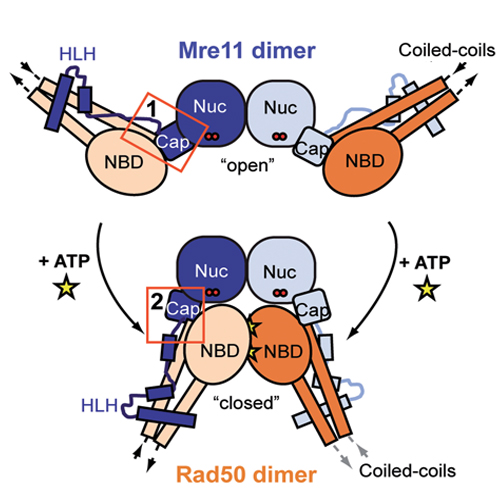ATP driven structural changes of the bacterial Mre11:Rad50 catalytic head complex
21-Sep-2011
Nucleic Acids Research, 2011, doi: 10.1093/nar/gkr749, 40 (2): 914-927. published on 21.09.2011
DNA double-strand breaks (DSBs) threaten genome stability in all kingdoms of life and are linked to cancerogenic chromosome aberrations in humans. The Mre11:Rad50 (MR) complex is an evolutionarily conserved complex of two Rad50 ATPases and a dimer of the Mre11 nuclease that senses and processes DSBs and tethers DNA for repair. ATP binding and hydrolysis by Rad50 is functionally coupled to DNA-binding and tethering, but also regulates Mre11's nuclease in processing DNA ends. To understand how ATP controls the interaction between Mre11 and Rad50, we determined the crystal structure of Thermotoga maritima (Tm) MR trapped in an ATP/ADP state. ATP binding to Rad50 induces a large structural change from an open form with accessible Mre11 nuclease sites into a closed form. Remarkably, the NBD dimer binds in the Mre11 DNA-binding cleft blocking Mre11's dsDNA-binding sites. An accompanying large swivel of the Rad50 coiled coil domains appears to prepare the coiled coils for DNA tethering. DNA-binding studies show that within the complex, Rad50 likely forms a dsDNA-binding site in response to ATP, while the Mre11 nuclease module retains a ssDNA-binding site. Our results suggest a possible mechanism for ATP-dependent DNA tethering and DSB processing by MR.











